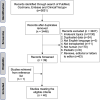Machine Perfusion for Human Heart Preservation: A Systematic Review
- PMID: 35401041
- PMCID: PMC8983812
- DOI: 10.3389/ti.2022.10258
Machine Perfusion for Human Heart Preservation: A Systematic Review
Abstract
Currently, static cold storage (SCS) of hearts from donations after brainstem death remains the standard clinically. However, machine perfusion (MP) is considered an approach for donor organ management to extend the donor pool and/or increase the utilization rate. This review summarizes and critically assesses the available clinical data on MP in heart transplantation. We searched Medline (PubMed), Cochrane, Embase, and clinicaltrials.gov, along with reference lists of the included publications and identified 40 publications, including 18 articles, 17 conference abstracts, and five ongoing clinical trials. Two types of MP were used: hypothermic MP (HMP) and normothermic MP (NMP). Three studies evaluated HMP, and 32 evaluated NMP. Independent of the system, MP resulted in clinical outcomes comparable to traditional SCS. However, NMP seemed especially beneficial for high-risk cases and donation after circulatory death (DCD) hearts. Based on currently available data, MP is non-inferior to standard SCS. Additionally, single-centre studies suggest that NMP could preserve the hearts from donors outside standard acceptability criteria and DCD hearts with comparable results to SCS. Finally, HMP is theoretically safer and simpler to use than NMP. If a machine malfunction or user error occurs, NMP, which perfuses a beating heart, would have a narrower margin of safety. However, further well-designed studies need to be conducted to draw clear conclusions.
Keywords: donor; heart preservation; heart transplantation; machine perfusion; review.
Copyright © 2022 Qin, Jernryd, Sjöberg, Steen and Nilsson.
Conflict of interest statement
The authors declare that the research was conducted in the absence of any commercial or financial relationships that could be construed as a potential conflict of interest.
References
-
- ISHLT. Adult Heart Transplantation Statistics (2020). Available from: https://ishltregistries.org/registries/slides.asp (Accessed May 12, 2020).
-
- Scandiatransplant. Transplantation and Waiting List Figures 2019 (2019). Available from: http://www.scandiatransplant.org/data (Accessed May 12, 2020).
-
- Nurmykhametova Z, Kaliyev R, Lesbekov T, Bekbossynov S, Bekbossynova M, Kapyshev T, et al. Sixteen Hours Ex-Vivo Perfusion for Heart Transplantation. Eur J Heart Fail (2018) 20:189. 10.1002/ejhf.1197 - DOI
Publication types
MeSH terms
LinkOut - more resources
Full Text Sources
Medical


